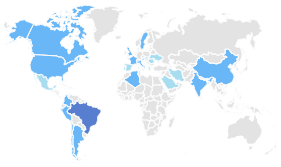Macro-Imagineering: Carpet Tidal Power-Plant Around the Peninsula Valdes in NE Chubut Province, Argentina
Resumo
Tidal power is a renewable energy source that is environmentally friendly and has many advantages over traditional power supply that produces waste products. This macro-imagineering proposal is based on mesochronic tidal inequalities between Golfo San José and Golfo Nuevo, separated by the Florentino Ameghino Isthmus that connects the Area Natural Protegida Península Valdés with the mainland on the Argentine southeast coast in Chubut Province. Hypothetical construction of a canal or tunnel across the 6-8 km wide isthmus would allow a hydropower channeling turbine to take advantage of the M2 tidal amplitude differential between the two bays to produce electrical energy for the immediately adjacent region. Additional beneficiation of the site would accrue from eco-tourism associated with the commercial tidal-range electricity-generation macro-project that envisages terrestrial as well as submarine bio-site visitations by tourists. Properly conducted macro-imagineering projects such as this proposal offer multiple advantages to coastal sites such as this one near the famed Peninsula Valdés in Argentina. During 2021, the United Nations is embarking on a Decade of the Ocean.
Key-words: Tidal energy, hydropower, renewable energy, tidal turbine, hydro-electricity supply, tidal barrage energy, eco-tourism, submarine sea tents, marine park.
===============================================================
As marés são fontes de energia renovável que não agridem o meio ambiente e apresentam muitas vantagens sobre as fontes tradicionais que geram resíduos. Esta proposta de macroimagenharia é baseada nas desigualdades mesocrônicas das marés entre o Golfo San José e o Golfo Nuevo, separadas pelo Istmo Florentino Ameghino que liga a Área Natural Protegida Península Valdés ao continente na costa sudeste da Argentina, província de Chubut. A construção hipotética de um canal ou túnel através do istmo de 6 a 8 km de largura permitiria que uma turbina de canalização hidrelétrica aproveitasse o diferencial de amplitude de maré M2 entre os dois golfos no intuito de produzir energia elétrica para a região imediatamente adjacente. Benefícios adicionais para o local seriam advindos do ecoturismo associado ao macroprojeto comercial de geração de eletricidade por faixa de maré, o qual prevê visitas a bio-sites terrestres e submarinos. Projetos de macroimagenharia adequadamente conduzidos, como a presente proposta, oferecem múltiplas vantagens para locais costeiros. Durante 2021, as Nações Unidas estão embarcando em uma Década do Oceano.
Palavras-chave: Energia das marés, energia hidrelétrica, energia renovável, turbina de maré, fornecimento de hidroeletricidade, energia das barragens de marés, ecoturismo, tendas submarinas, parque marinho.
Texto completo:
PDFReferências
Magazu, S. (December 2019) “The Vitruvian Man of Leonardo da Vinci as a Representation of an Operational Approach to Knowledge” Foundations of Science 24: 751-773.
Finkl, C.W. and Bologa, A. (March 2019) “Professor Roger H. Charlier (1921-2018)” Journal of Coastal Research 35: 481.
Neill, S.P. et al. (2018) “Tidal range energy resource optimization—Past perspectives and future challenges” Renewable Energy 127: 763-778. SEE also: Harcourt, F. et al. (1 March 2019) “Utilizing the flexible generation potential of tidal range power plants to optimize economic value” Applied Energy 237: 873-884.
Costello, M.J. et al. (2010) “Surface Area and the Seabed Area, Volume, Depth, Slope, and Topographic Variation for the World’s Sea, Oceans, and Countries” Environmental Science and Technology 44: 8821-8828.
Harris, P.T. et al. (2014) “Geomorphology of the oceans” Marine Geology 352: 4-24.
Isla, F.I. and Angulo, R.J. (July 2016) “Tectonic Processes along the South America Coastline Derived from Quaternary Marine Terraces” Journal of Coastal Research 32: 840-852.
Hinchey, E.K. et al. (2008) “Preface: Marine and coastal applications in landscape ecology” Landscape Ecology 23: 1-5.
Kopec, R.J. (December 1971) “Global climate change and the impact of a maximum sea level on coastal settlement” The Journal of Geography LXX: 541-550.
Mitrovica, J.X. et al. (2018) “All sea level is local” Bulletin of the Atomic Scientists 74: 142-147.
Frederikse, T. et al. (2019) “The imprints of contemporary mass redistribution on local sea level and vertical land motion observations” Solid Earth 10: 1971-1987.
Apontamentos
- Não há apontamentos.
Direitos autorais 2020 Charles W. Finkl, Richard Brook Cathcart
Indexadores, Diretórios, Bases de Dados e Registros (Abstracted and Indexed in):

CALIBRE - Revista Brasiliense de Engenharia e Física Aplicada
ISSN Eletrônico: 2526-4192































